One of the most notable monuments in the Giardini — in its position, and in itself — is of Venetian aviator Pier Luigi Penzo. Like his next-door neighbor, Francesco Querini, he too was involved in Arctic exploration and met a very distressing, unexpected, undeserved, all the “un”s you want, end. Yet somehow his story lacks some crucial element that makes Querini’s so riveting. I think it’s because the real focus of attention was on someone else.

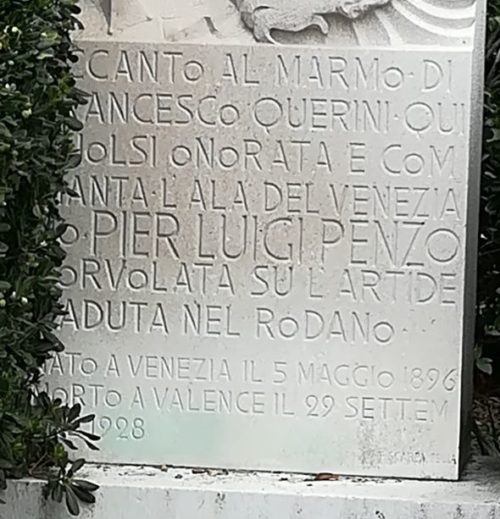
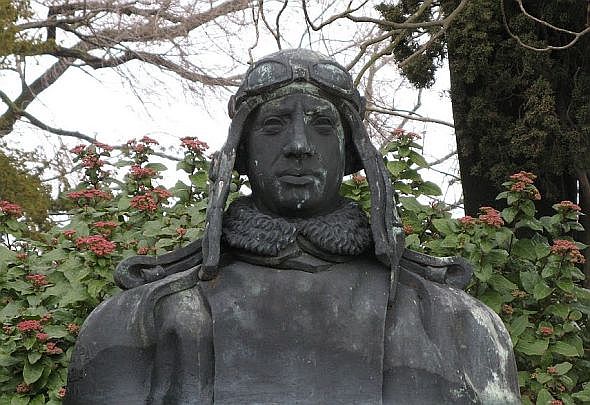
The barest outlines of his tale are that he participated in a massive rescue operation in the vicinity of the North Pole in 1928; on his flight home his plane struck some power lines near Valence, France and broke apart. It fell into the Rhone River, from which his remains were recovered two weeks later some 50 km (31 miles) downstream. I have found surprisingly little to add to that summary; Google searches mercilessly return articles about the Venetian soccer stadium, named — another sort of memorial — for him.
Therefore, and meaning no disrespect, you might be wondering why this person, who admittedly met a premature and unmerited demise, should have been given such an impressive monument. (In fact, two of them — the other is on the cemetery island of San Michele.)
I’m glad you wondered, because while the ill-fated expedition he was sent to rescue is lavishly described in numerous documents, not to mention a film (“The Red Tent,” 1969), Penzo himself seems not to have been the hero, but a team player in the grand sweep of several tragedies. I must describe these tragedies — some technical, some human, some political — in order to clarify why Penzo was literally put on a pedestal. Emotions of all sizes and sorts had been running extremely high.
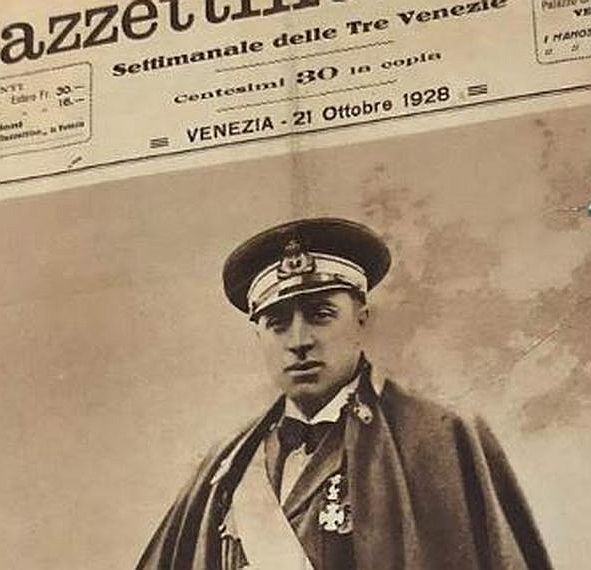
In drastically condensed form, we pick up the tale of Italian efforts to reach the North Pole in the autumn of 1925, when Norwegian explorer Roald Amundsen asked General Umberto Nobile of the Italian Royal Air Force to collaborate with him on a flight to the North Pole; Amundsen wanted to be the first to reach it by air. More to the point, he wanted to fly in a semi-rigid airship, and Nobile was already well-known as an important aeronautical engineer, pilot, and fervent proponent of dirigibles.
Nobile designed and piloted the airship Norge, accomplishing the first verified trip of any kind to reach the North Pole and likely the first verified flight from Europe to North America (Svalbard, Norway to Teller, Alaska) over the polar ice cap. This feat was known as the Amundsen-Ellsworth 1926 Transpolar Flight, so named for Lincoln Ellsworth who, with the Aero Club of Norway, financed the expedition. On May 12, 1926 at 1:30 AM GMT the North Pole was reached (though not actually touched). The flags of Norway, Italy, and the United States were dropped onto the ice and the airship proceeded to Alaska.
With the success of this exploit Nobile then planned another polar overflight, this time with an all-Italian crew in a dirigible named Italia. The project, however, met strong headwinds from his many enemies in the Fascist government, some of whom were also enemies of airships but huge fans of rigid aircraft. After grudgingly approving the expedition, Captain Italo Balbo, then-Secretary of State for the Air Force (later Minister of the Air Force), wished him a special bon voyage: “Let him go,” he is reported to have said, “for he cannot possibly come back to bother us anymore.”
The expedition went splendidly for a while. On May 23, 1928, after a 69-hour flight to the Siberian group of Arctic islands, the Italia began its flight to the North Pole with Nobile as both pilot and expedition leader. On May 24, the airship reached the Pole and began its homeward trip to Svalbard when it ran into a storm.
Rapidly losing altitude in the struggle against real headwinds, the next day the Italia crashed onto the pack ice fewer than 30 kilometers (18 miles) north of Nordaustlandet (astern part of Svalbard).
Of the 16 men in the crew, ten were thrown onto the ice as the gondola was smashed; without the weight of the gondola, the buoyant superstructure began to float away with six crewmen still inside it who, as they drifted skyward, threw all the supplies they could manage out onto the ice, which saved the lives of their severely injured comrades. The six were never seen again.
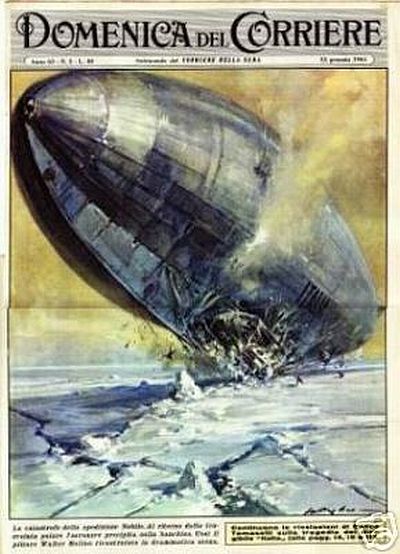
The men on the ice sent calls for help via a radio transceiver salvaged from the shattered gondola, but 30 days passed with no response. While a variety of the usual Arctic horrors were befalling them, an international rescue operation was seeking them — Soviet Russia, Norway, Sweden, Finland, and Italy, not to mention privately owned ships which had been chartered by polar scientists and explorers. Even Roald Amundsen put aside his bad feelings toward Nobile and boarded a French seaplane to aid in the rescue efforts. The plane disappeared between Tromsø and Svalbard, and though a pontoon from the craft was later found, the bodies of Amundsen and all aboard were not.
Enter Major Pier Luigi Penzo, joining the search on June 23, 1928 in his Marina II, an SM55-Dornier Wal hydroplane. Born in Malamocco, he had enrolled in the Italian Royal Navy at the age of 20, and earned his hydroplane pilot’s license at the seaplane base at Sant’ Andrea, just across from the Lido. He distinguished himself in combat on the Piave front in World War 1, and had become one of the most requested aerial rescue pilots then active. He was also well-known to Italo Balbo — I suppose you could say he was a friend — with whom he had flown on several occasions.
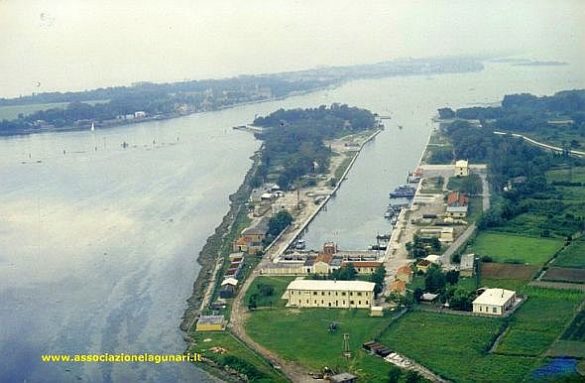
In the end, the survivors’ signals were picked up by a Russian ham radio operator who alerted the search teams, and it wasn’t even Penzo who spotted them for the first time, but fellow pilot Umberto Maddalena. And the first rescue plane to land was a Swedish Air Force Fokker ski plane piloted by Lieutenant Einar Lundborg.
Nobile had prepared a detailed evacuation plan, with the most seriously wounded man (the heavily built mechanic Natale Cecioni) at the top of the list and himself as number 4. But Lundborg refused to take anyone but Nobile, who also had been injured. Lundborg argued that the plane could only take one passenger, and Cecioni was so heavy the pilot was unsure he could take off. So Nobile was airlifted to safety, a captain who, it can’t be denied, had clearly not chosen to go down with his ship (so to speak). When Nobile boarded the Italian ship that served as expedition headquarters, he was arrested.
Worse still, when Lundborg returned alone to pick up the next survivor his plane crashed on landing, and he was left on the ice with the other five.
Meanwhile, Penzo and his crew (as well as another hydroplane) undertook a series of flights over the icepack dropping supplies and instruments to the marooned men. I can’t give any details on whether he took any survivors back to base.
After 48 days on the ice, the last five men of his crew were picked up by the Soviet icebreaker Krasin.
Time to leave? Nobile insisted that he wanted to stay to continue the search for the six men who were swept away in the airship when it disintegrated, but was ordered back to Rome with the others. He was to discover that the Arctic catastrophe wasn’t over, because it had given his enemies their chance to eliminate him.
When he and his men arrived in Rome on July 31, they were greeted by 200,000 cheering Italians. The popular exultation at the happy ending of the agonizing drama momentarily baffled Balbo and his allies, who had been seeding the foreign and domestic press with accusations against Nobile, claiming that agreeing to be evacuated first was an obvious sign of cowardice. (Pause to wonder why, in fact, Lundborg had insisted on taking him off before everybody else.) The official inquiry gave them the chance to place the blame for the disaster entirely on his shoulders. He was accused of abandoning his men, and Balbo went so far as to call for his execution by firing squad for treason and cowardice. Instead, Nobile resigned his commission and went to the United States, returning only in 1943 when Balbo was dead.
Here is a fuller, though still concise, account of the Italia disaster.
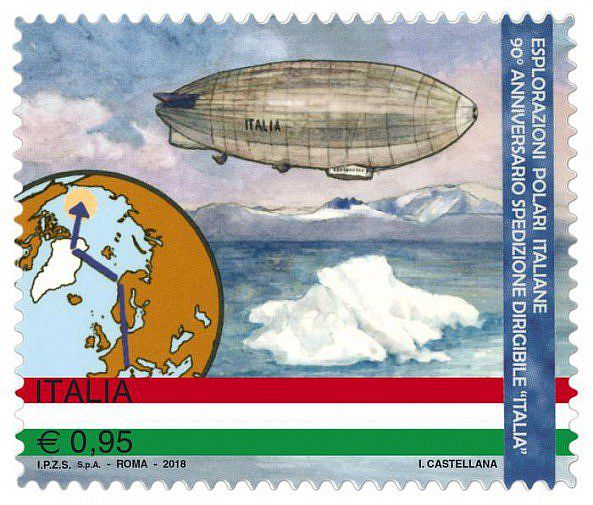
So, as I mentioned, there were tragedies: The technical tragedy was the crash of the “Italia”; the human tragedy was the loss of life; the political tragedy, as I see it, was the destruction of Nobile’s reputation. I don’t say he was right to be evacuated first, but the fact that the attacks on him were politically motivated is revolting.
In the months between the departure of the survivors in July and his own departure in September, Penzo remained at King’s Bay to continue the search for Amundsen, as well as for the six men lost in the envelope that floated away. In these flights he didn’t use his usual hydroplane, but a Macchi 18 biplane hydro-bomber (I throw that in for any aviation fans who might be reading). Unsuccessful in both cases, he was finally ordered back to Italy.
On September 27 (Thursday) he sent a telegram to his family that he was on his way home, and his brothers left Venice for Pisa, where his plane was expected to land on Friday. But it did not.
On Sunday morning a functionary of City Hall delivered the bad news to his wife. Two of his crew had survived the crash and been saved by fishermen, but Penzo and another two crewmen drowned. His remains were interred on the cemetery island of San Michele, under a honking big monument.
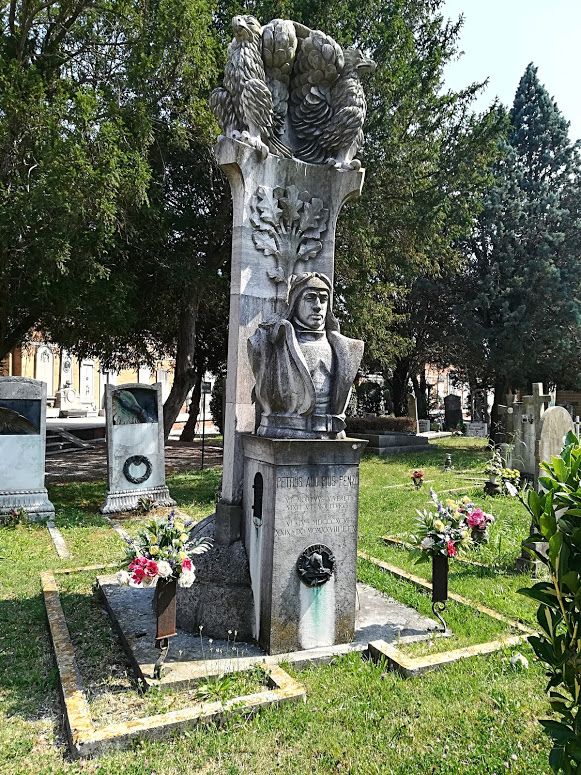
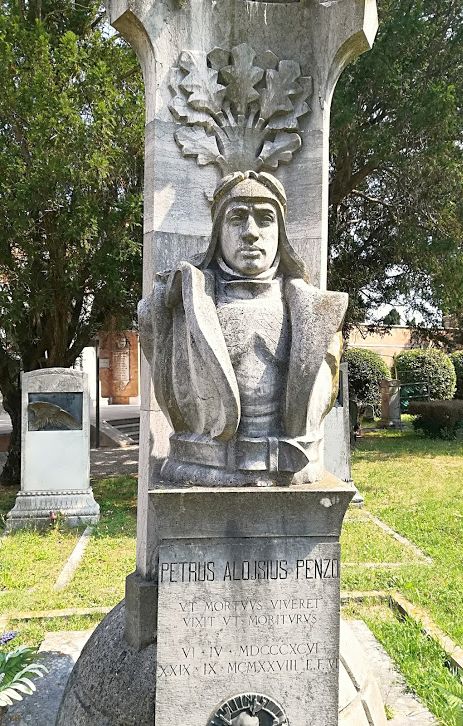
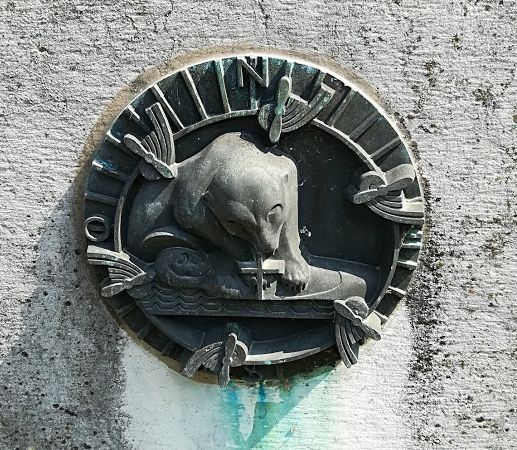
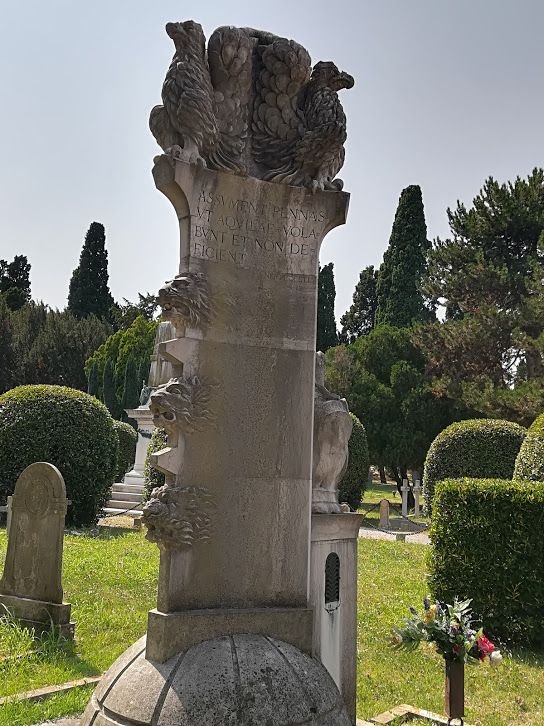
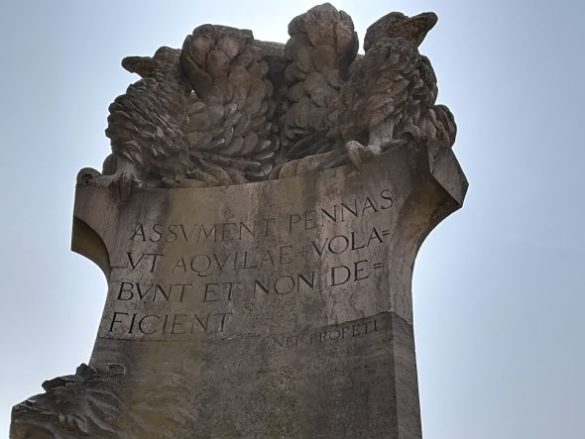

But wasn’t enough; another memorial, in a more public place, was seen as desirable, and it was unveiled at an inauguration ceremony on June 1, 1932 by — of course! — Italo Balbo, then Minister of the Air Force. He had organized an international aviation conference in Rome, and added Venice to the program.
It was obviously correct for him, in his official capacity, to honor a fallen comrade, but he must have enjoyed the chance to castigate Nobile once again by glorifying a man who had lost his life in the effort, more or less, to save him. At least that’s how I interpret this extravagant conclusion to Penzo’s life.
The monument was designed by Venetian sculptor Francesco Scarpabolla (1902-1999). “Oh sure,” said Lino when I shared this information. “I knew him, he lived just down the street from me near San Vio.” We were all expecting that by now, naturally.
But the best monument to Penzo, to my way of thinking, isn’t either one of the statues, nor even the soccer stadium (sorry). It’s the elementary school at Malamocco, which bears his name. Latin quotations and oak leaves are all very well, but the school is dedicated to a local boy, and it’s there that his name will truly be kept alive.
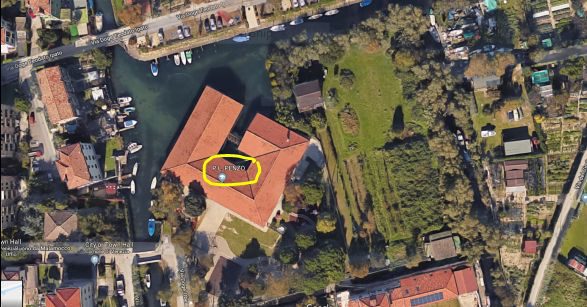

3 Comments
Thanks for this very interesting piece! I tried to find some information on him when I wrote my article about San Michele, but didn’t find much. I’m glad to finally read his intriguing story 🙂
Katia recently posted..San Servolo: A green island with a medical history
I enjoyed the aviation tale. Sounds like a lot of situations that include a mix of planes, politics, and power.